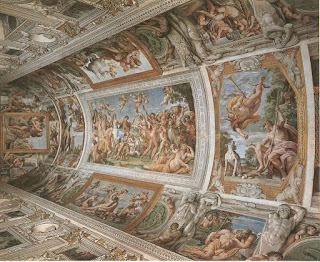Palazzo Farnese, first designed for the Farnese family, and expanded when Alessandro Farnese became Pope Paul III in 1534, is one of the most important High Renaissance palaces in Rome (It currently serves as the French Embassy, having been loaned to the French for 99 years beginning in 1936.). Annabelle Carracci, founding member of the "Carracci Academy" was invited to Rome in 1594 to decorate the study of Cardinal Odoardo Farnese and to paint the ceiling of the Farnese Gallery.
Why was Annabile invited to Rome?
First, the Carraci had developed a new painting style which accorded with the views and objectives of the Catholic Church. The key innovation for the Carracci was the melding of the design characteristics of Florentine art with the colors of Venetian art and their naturalism into a style that was characterized by clear, simple, direct imagery. This style comported well with the guidelines established by the Council of Trent and was enthusiastically endorsed in Rome.
Second, this new style had brought fame to the Carraci, especially Annabile. The Carracci came to dominate the religious art scene and their works began to show up in many churches, chapels, and cathedrals. They worked together, for example, on the Palazzo Fava in 1583 and the Palazzo Magnani in 1590-92.
Third, connections. According to Vodret and Granata (Not only Caravaggio), "Even though (Pope) Innocent ruled for only two months (ed., November 3 to December 31, 1591), he found time to develop closer ties with Alessandro Farnese and Paolo Emilio Sfondrati, who were, as Morselli observes, very important points of reference in the careers of Annibale Caracci and Guido Reni."
Annibale traveled to Rome in 1595 and decorated a small chamber called Sala d'Ercole rather than the study. In 1597 he was commissioned to decorate the barrel-vaulted gallery on the palace's main floor. The frescoes were ordered in celebration of the wedding between Ranuccio Farnese and Pope Clemente VIIIs niece Margherita Aldobrandini. The contract allowed for food-related expenses to be deducted from the overall contract cost. The design called for mythical figures -- rather than the religious scenes that were more in vogue at that time -- in order to comport with the Farnese antique art collection.
Annabile invited his brother and cousin to join him in Rome to work on the commission. Ludovico was comfortable working with the students at the Academy in Bologna and opted to remain there. His elder brother Agostino joined him but they could not get along so he left.
The work was created in large part between 1597 and 1601 but was not finalized until 1608. According to Vodret and Granata:
Annibale painted the vault of the gallery with "various emblems representing war and peace between sacred and profane love as described by Plato" ... mythological scenes were inserted into a fictive architectural framework that combines marvelously sculptural and naturalistic elements, medallions, and framed pictures that represent a joyful series of stories about the loves of the gods, culminating in the nuptial scene the Triumph of Bacchus and Ariadne. Ingeniously inspired by Michelangelo's ceiling in the Sistine chapel, Carracci's vault is a festive counterpoint, and with its luminous colors, and the naturalistic handling of fleshy figures and airy horizons, it points to the exuberant expressivity of the Baroque.
Selected aspects of the frescoes are shown in the following frames.
 |
| The Loves of The Gods on the vaults of the Farnese Gallery Annabile Carracci, 1597 - 1601 |
 |
| Farnese Gallery, 1597 - 1608 Annabile Carracci and studio |
 |
| Farnese Gallery, 1597 - 1608 Annabile Carracci and studio |
 |
| Polyphemus and Galatea, 1597 - 1608 Annabile Carracci and studio |
According to Vodret and Granata,
The frescoes on the gallery walls (1602-3), which are connected thematically to the ceiling, were painted by Carracci's excellent students, including Domenichino and Lanfranco. These and the other Bolognese artists who came to Rome to study with Annabile and to work with his shop achieved what was almost a monopoly on all the large-scale fresco commissions in Roman villas, palaces, and churches in the first decades of the seventeenth century.
In this effort Annibale "introduced a new grand manner of fresco painting" which was "ranked alongside The Sistine Chapel and Raphael Rooms as the greatest achievement of monumental fresco painting. This new style paved the way for the new idiom of Baroque painting" (visual-arts-cork.com). The unveiling of the ceiling in 1601 brought great acclaim and demand for Annabile's work.
Most painters working in Rome at that time were either flashy, or aggressive, or both. Annabile was neither. He was rather retiring and a poor dresser. The Cardinal did not approve of his demeanor and looks and was very disrespectful to him during the course of the project. Annibale did not take visible offence and kept his head down and the work going. The culmination of the effort was too much for him to bear though. At the completion of the effort the Cardinal subtracted the food costs and paid Annibale a paltry sum. Annibale fell into a deep depression as a result and ceased painting. Rather, he would do sketches which would then serve as the basis for paintings from his students. Annibale died in 1609.
©EverythingElse238





No comments:
Post a Comment